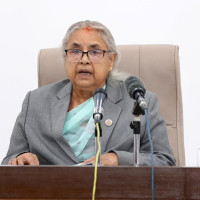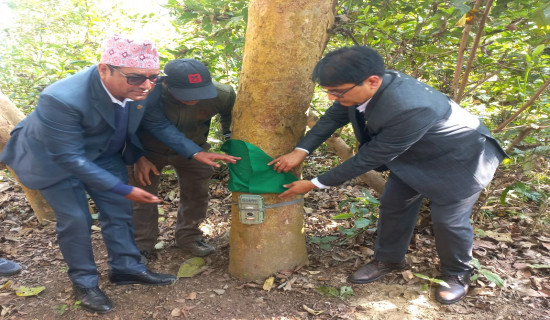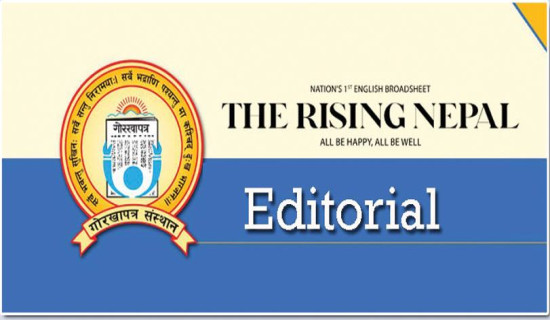- Tuesday, 16 December 2025
Development Aid In Need Of Review
Unequal distribution of wealth is the main reason for a section of the population to reel from abject poverty while for others, especially in the developed world, it is a means of luxurious and secure life. Charity and aid, by wealthy nations and individuals, seek to overcome this unequal allocation of resources so that those, who are unable to afford to fulfil their basic needs, live a life of dignity and happiness. While charity aims to make sure people don’t die of hunger and lack of medical assistance, other aid aims to address the need to develop the capacity and awareness among those who have less to develop their capacity to have a proper livelihood and move towards sustainability. This helping hand approach is also instrumental in reducing the adverse impacts on the financial ecosystem of the world.
Ever since Donald Trump was inaugurated as the 47th President of the United States of America for the second time, his policy of freezing aid that was channelled all over the world via USAID has sent shockwaves in the development sector. Development is the key to the progress of humans, and unequal developments in different parts of the world can have negative effects on human development. In his article ‘Money Matters: Tracking the impact of USAID’s demise’, David Ainsworth writes that USAID had already promised to spend almost 60 billion US dollars that may not be funded now. It also mentions that USAID’s largest grantees and contractors have lost out on 2.7 billion US dollars a year in funding.
Reliance
Depending on the country where USAID aid was extended, some grantees depended on them for under a fifth of their funding and some relied on USAID funding for more than 80 per cent of all revenues. There are some units at the United Nations which rely on US support for more than 40 per cent of their income. This could lead towards massive job cuts. The development sector around the world is aghast with this turn of events. Those who have multiple support and diversified aid can manage their work with other sources, but many organisations rely on USAID for more than half of their incomes and some have only one month’s funding to keep them going.
According to the website USAIDSTOPWORK, around 51,946 Americans will lose their jobs. Similarly, there are 100,000+ jobs lost globally. The development aid is aimed at helping those who do not have enough to survive. Therefore, foreign aid is often not just charity. It is an investment by wealthy nations to create stability and improve diplomacy and the interests of the bigger nations and countries. Therefore, it can be said that when the bigger nations withdraw from their investments in aid to developing nations, they are going against the interests of their own countries and move towards making themselves vulnerable to some extent.
Investments by developed countries in developing nations create more resilient markets for the bigger nations. USAID was, in fact, creating a more resilient market for US exports in the countries they were providing development aid. It was also benefitting the supply chains of US industries that imported goods from developing nations. US has always been seen as a leader in humanitarian work and human rights values. Their aid actually was seen as a medium of improving trading systems and reducing barriers to trade in the developing nations.
The USAID is also working on reducing conflict, disaster and prevention of disease. With cuts in these important areas, there is speculation that the spread of violence, instability, and transitional crime could spike up in areas where work was being done via their support. The budget that is spent through USAID is just 1 per cent of the federal budget. The ReliefWeb claims that USAID contributed approximately 37 per cent of their global budget, therefore the cut will hurt their work. Although they commit to continuing their support, they state that the training and educational work they were doing will have a backlash. Development aid invests a lot in the educational activities of those populations who do not have enough resources for that. USAID cuts will hamper such activities mainly on underprivileged people, especially girls and women.
Impact on Nepal
Nepal has been a recipient of US support since 1954. Now the suspension notice that was communicated by the US government to the Nepal government will have an impact. According to the Nepal Foreign Ministry, the Development Objective Agreement signed between Nepal and USAID on May 5, 2022, has been halted for 90 days. This agreement included four On-Budget On-Treasury programmes for health, agriculture, education and inclusion. According to the Nepal Ministry of Finance, out of USAID-assisted projects worth 695 USD in Nepal, 411 million was committed in the last fiscal year.
This aid suspension will hit Nepal’s development works. However, there are many experts, who think that a cut in USAID support, especially, given to Nepali political parties could be positive. They argue that such interventions could have created unfavourable development in Nepal which the Trump Administration could rectify if planned properly.
One interesting aspect of the USAID cut is the fact that this does not seem to apply to the Millennium Challenge Corporation programme. This is a 500-million US dollar programme which was commenced in 2017 and ratified and agreed upon by Nepal’s parliament in 2022. This programme is committed to building electricity transmission lines that can supply excess electricity from Nepal to India. Retaining this could be a geopolitical interest of the USA. The actual outcome of Trump’s cut of USAID all over the world is yet to be seen. However, this has given food for thought to the developing nations to support each other and come up with a strategy to develop themselves on their own terms and conditions.
(Sharma is a senior journalist and women’s rights advocate. namrata1964@yahoo.com or on X @NamrataSharmaP.)

















